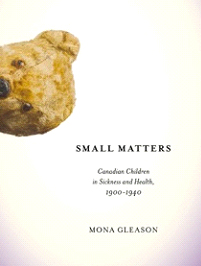The Power of Empathetic Engagement: History Education and the History of Children and Childhood (Mona Gleason)

Unlike many other specialized areas under the umbrella of social history, the history of children and childhood has an audience that can readily identify with it. After all, no matter who we are (or how old we are), we were all youngsters once upon a time. Drawing from my recent book, Small Matters: Canadian Children in Sickness and Health, 1900 to 1940 (Montreal-Kingston: McGill-Queen’s University Press, 2013), I suggest in this research snapshot how empathetic engagement with my primary field, the history of children, can enhance history education for both educators and learners. In relation to historical understanding, empathetic engagement signals a deep connection with the experiences of people in the past. This kind of engagement offers a powerful opportunity for educators and students to see themselves in the past and to contemplate, perhaps in new ways, why and how change over time matters.
Empathetic engagement with people and events is a powerful way to draw learners into history education. Dedicated educators are constantly on the lookout for ways to make history “come alive” for their students. Likewise, learners are drawn to historical material that is relevant and “speaks to them.” When we identify with what we are learning, investing emotionally and intellectually in it, we immediately recognize its significance and are more likely to value it. This is at the core of the empathetic advantage that accompanies learning about the history of children and childhood. Our own memories of growing up, becoming social beings, going to school, forging friendships, and enduring hardships, connects us with those in the past in an incredibly intimate way. Older students readily remember how they felt when their parents, teachers, or caregivers disciplined them, what their favourite childhood toy meant to them, the pain of being teased at school, or the joy associated with family holidays and traditions. Younger children are in the middle of these important social and cultural events in their lives and have immediate insight into how they contribute to their sense of self and place in the world. Stories of growing up, comprising both positive and negative experiences, connect us with children in the past and with each other. The importance of oral history to the production of histories of children and childhood also enables students to learn about the challenges and opportunities associated with this method.
 A common dimension of childhood, learning about good health habits and dealing with illness, provides a ready-made pathway into this complicated yet revealing relationship with memory and history. In Small Matters, oral histories of women and men who grew up across Canada contribute a myriad of stories about what they learned (and didn’t learn) about health in schools and at home. Many families, for example, dealt with the common affliction of head lice by pouring kerosene on children’s heads and leaving it on for hours. The treatment, while effective against lice, left children with irritated and painful scalps. Once treated, children would return to school, often encountering ridicule and bullying for being considered “dirty.” This kind of history demonstrates why contemporary educators work hard to deliver the message that head lice is not an indicator of lack of cleanliness and that bullying has a long and infamous history!
A common dimension of childhood, learning about good health habits and dealing with illness, provides a ready-made pathway into this complicated yet revealing relationship with memory and history. In Small Matters, oral histories of women and men who grew up across Canada contribute a myriad of stories about what they learned (and didn’t learn) about health in schools and at home. Many families, for example, dealt with the common affliction of head lice by pouring kerosene on children’s heads and leaving it on for hours. The treatment, while effective against lice, left children with irritated and painful scalps. Once treated, children would return to school, often encountering ridicule and bullying for being considered “dirty.” This kind of history demonstrates why contemporary educators work hard to deliver the message that head lice is not an indicator of lack of cleanliness and that bullying has a long and infamous history!
Other children suffered through conditions that are common and readily treated today, like earaches, for which effective treatments simply did not yet exist in the past. In an era before the general acceptance of vaccination, children who contracted serious illnesses, such as meningitis, small pox, chicken pox, and whooping cough, often died or spent months, even years, in hospital. In a chapter in Small Matters devoted to the experience of hospitalization, adults tell very poignant stories of the extreme loneliness they felt as children during their time in care. Medical thinking prior to the early 1960s held that hospitalized children should be sequestered to prevent additional family members from becoming ill. Doctors and nurses also reasoned that seeing parents would only make things worse when the visit had to inevitably end.
Oral histories that give voice to diverse racial and class backgrounds, including those that shed light on gendered norms in the past, highlight important themes of inclusion, exclusion, power dynamics, resiliency, and prejudice in the history of children. The experiences of non-white children, including First Nation peoples, and those labeled as disabled, are front and centre in Small Matters and help students explore the past as a contested terrain, even for the youngest of Canadians. Through the power of empathetic engagement, students of all ages readily connect with these memories. Many have their own experiences of illness, loneliness, and resiliency to draw upon and are readily inclined to probe deeper into why and how attitudes towards children, their capacities and their needs, have changed over time. By embracing these and other advantages of empathetic engagement with a youthful past, educators and learners can experience a history that has the potential to truly speak to them.
- Se connecter ou créer un compte pour soumettre des commentaires
- Français

